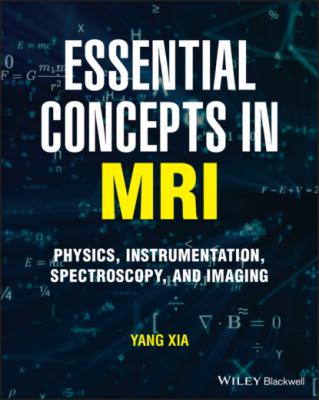ТОП просматриваемых книг сайта:
Essential Concepts in MRI. Yang Xia
Читать онлайн.Название Essential Concepts in MRI
Год выпуска 0
isbn 9781119798248
Автор произведения Yang Xia
Жанр Медицина
Издательство John Wiley & Sons Limited
One of the two B1(t) components (which rotates in the same direction as ω0) will have strong influence on the nuclei despite its small magnitude compared with B0, while the other component, which rotates in the opposite direction, will have negligible effect on the nuclei (provided |B1| ≪ B0).
It will be very useful to introduce a rotating frame of reference, as shown in Figure 2.6, where the xyz frame is the laboratory frame of reference (stationary) and the x′y′z′ frame is the rotating frame of reference at an angular frequency ω′ in the laboratory frame, in which z and z′ are parallel. In addition, one of the B1(t) components appears stationary in the rotating frame; let’s set that stationary component of B1(t) along the x′ axis.
Figure 2.6 (a) A magnetic moment µ precessing in the stationary (xyz) and rotating (x’y’z’) frames. (b) A macroscopic magnetization vector M in the two frames.
When a magnetic moment is precessing at a rate of ω0 in the xyz frame, a stationary observer in the x′y′z′ frame should see the magnetic moment precessing at a reduced rate ω0 – ω′. Since ω = γB, a reduced precession rate implies that the magnetic moment is experiencing a reduced B0, as
In the presence of both B0 and B1(t) fields, the total vector field Btotal is the sum of all fields and the effective field Beff varies with the frequency of B1(t), as
and
where Eq. (2.12) is for the stationary xyz coordinates and Eq. (2.13) is for the rotating x′y′z′ coordinates. The directions of these vector fields are shown schematically in Figure 2.7.
Figure 2.7 In the rotating frame that has a frequency ω′, the external magnetic field B0 appears to be reduced in magnitude, where the reduction is a function of ω′. This reduction results in the tipping of Beff towards the x’ axis, which is in parallel with B1.
In a typical NMR system, |B1| is several orders of magnitude smaller than B0, which means that Btotal is almost along the z axis. However, the magnitude and the direction of Beff will drastically depend upon the frequency of the rotating frame ω′. When ω′ approaches the value of ω0, the effective magnetic field Beff tips more towards the transverse plane. When ω′ = ω0 (i.e., the frequency of B1(t), ω′, equals the Larmor frequency ω0), the second term in Eq. (2.13) becomes zero. Hence B1(t) becomes the only field in Beff to interact with the nuclei. M will therefore respond to the effect of B1(t), which is set along the x′ axis (Figure 2.7). This condition, ω′ = ω0, is termed as the resonance condition.
Under this resonance condition, the magnetization will be tipped away from its equilibrium orientation towards the transverse plane under the influence of B1(t), as ω1 = γB1 (Figure 2.8). Since the effective component of B1(t) has been set along the +x′ axis, the magnetization will rotate about B1 in the y′z′ plane of the rotating frame. Following the notation for rotation as shown in Figure 1.3b, the direction of the magnetization towards the transverse plane under the influence of a B1 field set along the +x′ axis follows the circular trajectory in Figure 2.8b, towards the +y′ axis.
Figure 2.8 Motion of the magnetization in the rotating frame and the laboratory frame, under the influence of a B1 field set along the x’ axis. (a) M is at the thermal equilibrium, along the z axis. (b) M tips towards the transverse plane when B1 is turned ON. (c) M reaches the transverse plane (which is to say that M has been rotated by 90˚).
Note that this rotation of the magnetization towards the +y′ axis under a B1 field set at the +x′ axis is determined by the convention of positive rotation that is set earlier in Figure 1.3. As we mentioned in Chapter 1.2, different textbooks and academic papers contain inconsistencies in the notation for rotation of M, to either the –y′ axis or +y′ axis upon a B1 field set along the +x′ axis, depending upon which direction is labeled as the positive rotation. Although this discrepancy seems problematic for the graphical illustration of vectoral motion of magnetization at the first appearance, it does not matter as long as one chooses one notation and keeps it for the entire analysis of spin evolution.
Since B1 is several orders of magnitude smaller than B0, ω1 is typically tens to hundreds of kilohertz (instead of a typical ω0 at tens to hundreds of megahertz). The time to tip the magnetization from the thermal equilibrium towards the transverse plane is typically several to tens of microseconds (µs), depending upon the magnitude of the B1 field. A particular B1 that is able to tip the magnetization from its z axis to the transverse plane (to the +y′ axis, as shown in Figure 2.8c in the rotating frame x′y′z′) is termed in practice as a 90˚ B1 field (or more commonly a 90˚ B1 pulse, or a π/2 pulse). The term pulse in the last sentence refers to the short duration of the B1 field; see Section 2.10 for the definition of rf pulses and Chapter

